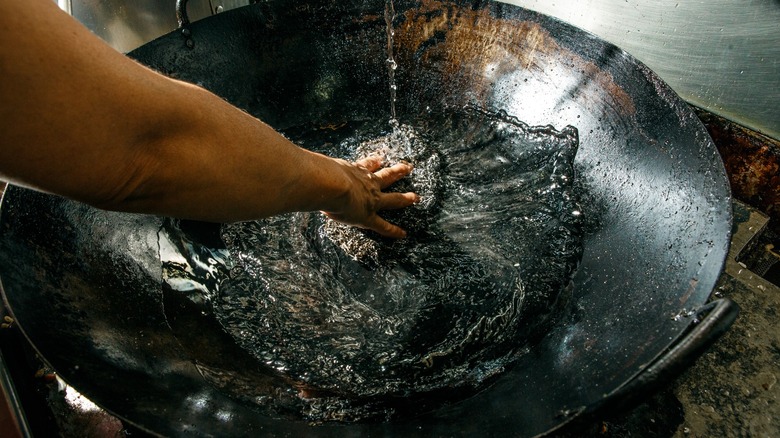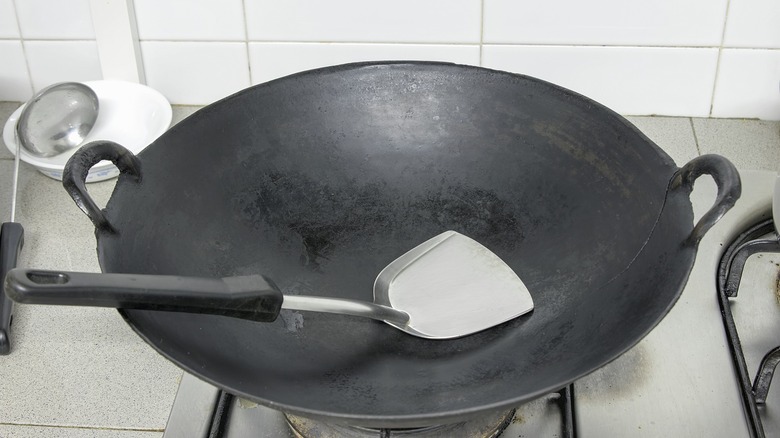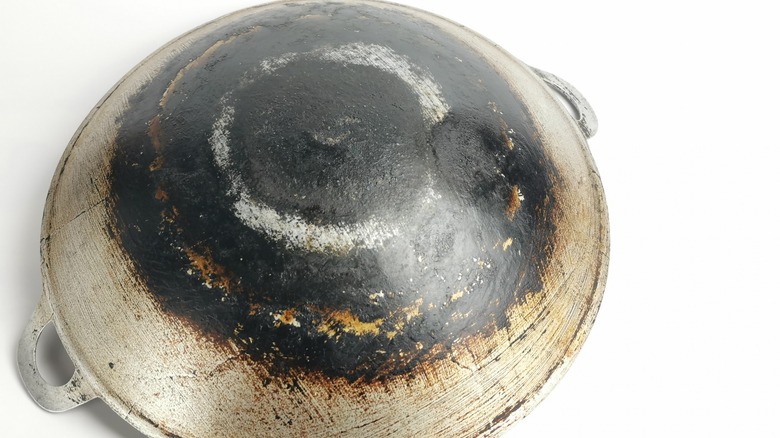How To Clean A Wok With Food Stuck On It
A wok is a wonderfully flexible kitchen tool that can cook all manner of mixed ingredients as long as you can fit them inside. All that stir-frying will, however, inevitably lead to bits of burnt food stuck to the surface, no matter how assiduously you season and oil up the carbon-steel surface. Fortunately, cleaning a wok simply requires scrubbing the residue off and making sure it's properly seasoned, a painless affair as long as you are consistent about it.
High heat and liberal use of oil will help prevent food from sticking to the wok in the first place, so try to start cleaning before the wok has cooled down. The simplest wok to clean a wok is to dampen it and use a spatula, perhaps the one you used while actually stir-frying, to scrape up the sticky bits. Using a metal tool may sound risky because it might leave scratches, but those are just indents in the layer of patina that has built up and can be seasoned back up.
Once you've scraped off the most significant bits of leftover food, it's time to give it a scrub. Regular sponges may not be powerful enough to wipe off all the grease and burnt material, so opt for a scrub brush or use the scouring pad side of your kitchen sponge. Wok brushes are available if you want something specialized, but they're not necessary.
How to season your wok after cleaning it
Once you've washed your work, it's important to remember not to leave it to dry on a rack since rust can build up fast on material like carbon steel. Instead, put it back over the stove and warm it up over low heat until all the moisture is gone. Wiping it off with a towel can dry a wok off, as well, but heating it up on the stove is the most surefire way to avoid rust. Finally, your wok probably needs some light seasoning after scrubbing off some of the patina, so it's never a bad idea to use a paper towel to coat the surface with a thin layer of vegetable oil before storing it.
If you need a deeper seasoning, however, you'll have to heat it over the stove yet again after coating both the inside and outside with high smoke point oil. This will not only act as an anti-adhesive against more food bits but also an anti-rust element. You usually don't want to see too much smoke when cooking over the stove, but in this case, it means that the wok is hot enough to absorb the oil and re-coat the carbon steel layer underneath with a new patina. The final result should be a shiny, slightly thick surface.
What not to do when cleaning a wok
Although you can soak your wok for about five minutes in warm water to help remove debris, it's a bad idea to leave it bathing for too long. An overnight soak is almost sure to make the carbon steel rust over, just as it would with a cast iron skillet. Woks are more versatile than merely a stir-fry pan and can, in fact, make for an effective steamer. If you use it this way, however, remember to immediately pour out the water once you're done. The same goes for leaving food, especially anything acidic, inside for too long. Some woks are cast-iron or aluminum instead of carbon steel, but the same logic applies to these materials. On the other hand, nonstick woks exclude almost all of this advice because they're simply not as durable. They can't handle high heat, so they should never smoke. A metal tool will scrape off the nonstick coating, and soaking them in water after they're hot can cause them to warp.
In addition, if the wok is especially greasy or you're squeamish about the fact that you used it to cook raw meat, you can use a pinch of mild dish soap. However, soap is highly effective at cutting through patina, so use it with caution. Finally, if you think you've done more harm than good, don't panic. You can always re-season your wok.



